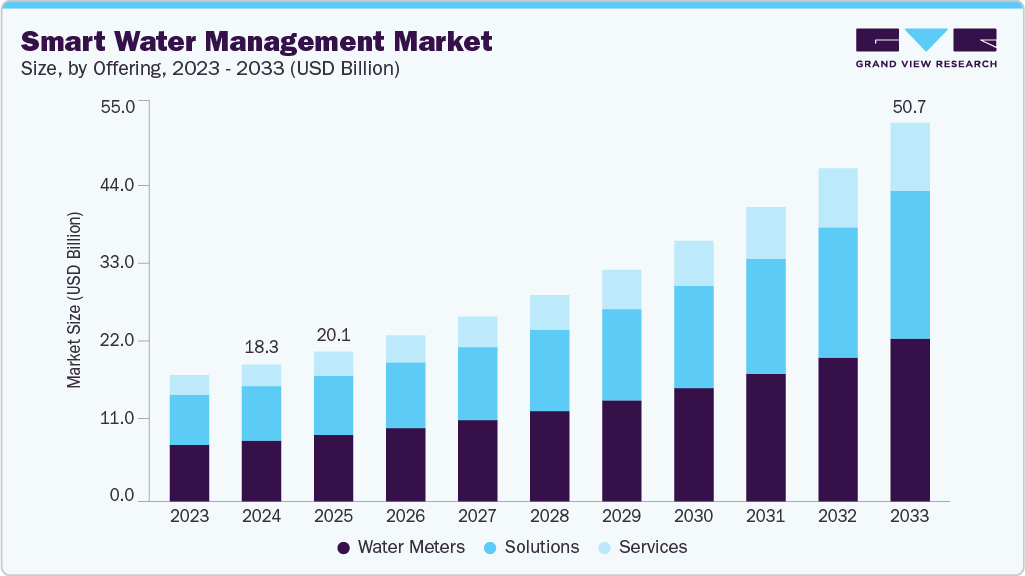Smart Water Management Market Size, Share & Trends Analysis growing at a CAGR of 12.7% from 2025 to 2033

The global smart water management market size was estimated at USD 18,340.5 million in 2024 and is projected to reach USD 50,740.8 million by 2033, growing at a CAGR of 12.7% from 2025 to 2033. The market growth is primarily driven by rising concerns over water scarcity, increasing government regulations for water conservation, and growing investments in digital water infrastructure.
Key Market Trends & Insights
- North America dominated the global smart water management market with the largest revenue share of 34.0% in 2024.
- The smart water management market in the U.S. led the North America market and held the largest revenue share in 2024.
- By offering, the water meter segment led the market and held the largest revenue share of 44.5% in 2024.
- By end use, the industrial segment held the dominant position in the market and accounted for the leading revenue share of 43.8% in 2024.
Market Size & Forecast
- 2024 Market Size: USD 18,340.5 million
- 2033 Projected Market Size: USD 50,740.8million
- CAGR (2025-2033): 12.7%
- North America: Largest market in 2024
Request a free sample copy or view report summary: https://www.grandviewresearch.com/industry-analysis/smart-water-management-swm-market/request/rs1
The increasing pressure from population growth, rapid urbanization, and escalating water scarcity is accelerating the demand for smart water management solutions. Traditional water infrastructure systems often struggle to cope with rising consumption and deteriorating resource availability, prompting municipalities and utilities to adopt intelligent alternatives. Smart water management industry leverages advanced technologies such as IoT sensors, real-time data analytics, and automated control systems to reduce water loss, optimize distribution, and improve water quality. Governments and utilities are investing in smart solutions to enhance resource efficiency, ensure regulatory compliance, and promote sustainable water use, driving market expansion.
Innovations in IoT, AI, and data analytics are significantly enhancing the capabilities of smart water management systems, revolutionizing how water resources are monitored and managed. IoT sensors and devices facilitate real-time monitoring of water quality, pressure, and flow, providing immediate insights into system performance and potential issues. AI algorithms analyze this vast amount of data to predict maintenance needs, detect leaks, and optimize water distribution. Data analytics enables utilities to gain actionable insights into consumption patterns, allowing for more efficient resource allocation and demand management. The growing adoption of these technologies is reshaping the smart water management industry landscape.
Additionally, the rising global emphasis on sustainability and environmental conservation is driving demand for smart water management. Increasing water scarcity and climate-related challenges, governments and industries are prioritizing efficient resource utilization and sustainable practices. Technologies enable proactive water conservation through automated monitoring and adaptive control systems, helping meet regulatory requirements and environmental goals. This alignment with sustainability objectives is significantly contributing to market growth.






